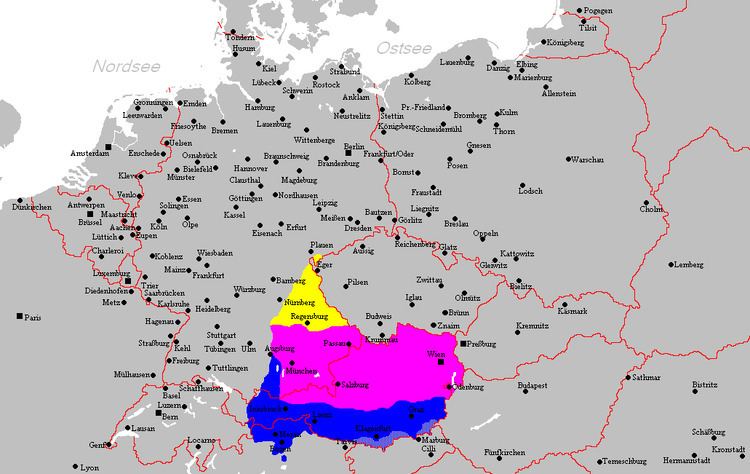Native speakers 14,000,000 (2015) | ISO 639-3 bar | |
 | ||
Language family Indo-EuropeanGermanicWest GermanicIrminonesHigh GermanUpper GermanBavarian Glottolog bava1246 (Bavarian proper)baye1239 (Bayerisch) | ||
Bavarian (Austro-Bavarian: Boarisch [ˈbɔɑrɪʃ]; German: Bairisch [ˈbaɪ̯ʀɪʃ]; Hungarian: bajor), is a major group of Upper German varieties spoken in the southeast of the German language area, largely covered by Bavaria and Austria. It forms a continuum of more or less mutually intelligible local and regional variants.
Contents
History
The Bavarians as a group formed in the early medieval period, as the population of the Duchy of Bavaria, forming the south-eastern part of the kingdom of Germany. The Old High German documents from the area of Bavaria are identified as Altbairisch ("Old Bavarian"), even though at this early date there are few distinctive features that would divide it from Alemannic. The dialectal separation of Upper German into East Upper German (Bavarian) and West Upper German (Alemannic) becomes more tangible in the Middle High German period, from about the 12th century.
Geographical distribution and dialects
Three main dialect groups in Bavarian are:
Differences are clearly noticeable within those three subgroups, which in Austria often coincide with the borders of the particular states. For example, each of the accents of Carinthia, Styria, and Tyrol can be easily recognised. Also, there is a marked difference between eastern and western central Bavarian, roughly coinciding with the border between Austria and Bavaria. In addition, the Viennese dialect has some characteristics distinguishing it from all other dialects. In Vienna, minor, but recognizable, variations are characteristic for distinct districts of the city.
Use
In contrast to many other varieties of German, Bavarian differs sufficiently from Standard German to make it difficult for native speakers to adopt standard pronunciation. All educated Bavarians and Austrians, however, can read, write and understand Standard German, but may have very little opportunity to speak it, especially in rural areas. In those regions, Standard German is restricted to use as the language of writing and the media. It is therefore often referred to as Schriftdeutsch ("written German") rather than the usual term Hochdeutsch ("High German" or "Standard German").
School
Bavaria and Austria officially use Standard German as the primary medium of education. With the spread of universal education, the exposure of speakers of Bavarian to Standard German has been increasing, and many younger people, especially in the region's cities, and larger towns speak Standard German with only a slight accent. This accent usually only exists in families where Bavarian is spoken regularly. Families that do not use Bavarian at home usually use Standard German instead. In Austria, some parts of grammar and spelling are taught in Standard German lessons. As reading and writing in Bavarian is generally not taught at schools, almost all literate speakers of the language prefer to use Standard German for writing. Regional authors and literature may play a role in education as well, but by and large, Standard German is the lingua franca.
Literature
Although there exist grammars, vocabularies, and a translation of the Bible in Bavarian, there is no common orthographic standard. Poetry is written in various Bavarian dialects, and many pop songs use the language as well, especially ones belonging to the Austropop wave of the 1970s and 1980s.
Although Bavarian as a spoken language is in daily use in its region, Standard German, often with strong regional influence, is preferred in the mass media.
On the use of Bavarian and standard German in Austria see Austrian German.
Ludwig Thoma is a noted author who wrote works such as Lausbubengeschichten in Bavarian.
Web
There is a Bavarian Wikipedia, completely in Bavarian.
Consonants
Notes:
Vowels
Bavarian has an extensive vowel inventory, as is common for Germanic languages. Vowels can be grouped as back rounded, front unrounded and front rounded. They are also traditionally distinguished by length or tenseness.
Grammar
The commonly accepted grammar and spelling system for Bavarian has been documented by A. Schmeller; see more details at the German Wikipedia page for Bairische Dialekte
Personal pronouns
* These are typically used in the very northern dialects of Bavarian.
Possessive pronouns
The possessive pronouns Deina and Seina inflect in the same manner. Oftentimes, nige is added to the nominative to form the adjective form of the possessive pronoun, like mei(nige), dei(nige), and the like.
Indefinite pronouns
Just like the possessive pronouns listed above, the indefinite pronouns koana, "none", and oana, "one" are inflected the same way.
There is also the indefinite pronoun ebba, "someone" with its impersonal form ebbs, "something". It is inflected in the following way:
Interrogative pronouns
The Interrogative Pronouns wea, "who", and wås, "what" are inflected the same way the indefinite pronoun ebba is inflected.
Society
Bavarians produce a variety of nicknames for those who bear traditional Bavarian or German names like Josef, Theresa or Georg (becoming Sepp'l or more commonly Sepp, Resi and Schorsch, respectively). Bavarians often refer to names with the family name coming first (like da Stoiber Ede instead of Edmund Stoiber). The use of the article is considered mandatory when using this linguistic variation. In addition, nicknames different from the family name exist for almost all families, especially in small villages. They consist largely of their profession, names or professions of deceased inhabitants of their homes or the site where their homes are located. This nickname is called Hausname (en: name of the house) and is seldom used to name the person, but more to state where they come from or live or to whom they are related. Examples of this are:
